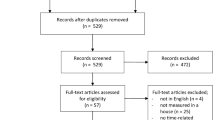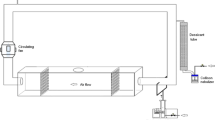Abstract
The determination of mite numbers in dust samples depends on the effectiveness of the sampling procedure. We report on mite isolation from dust samples by flotation distinguishing between living and dead mites. The results are varied and unreproducible; ageing processes are of relevance in the case of dead mites. Living mites can be determined more reliably when using mite mobility. Two methods based on this principle, the mobility test and the heat escape method, are described and discussed. In the case of a natural analogous mite development on carpets, mite numbers ranging from 80 000 to 200 000 mites per m2 are found after approx. 3 months. It is shown that the mobility of different mite species varies. The mobility test allows the detection of mites in textile objects, and shows how mites are distributed over these objects. It is demonstrated how the infestation of clothes by mites can be determined.
Similar content being viewed by others
References
Arlian, L.G., 1972. Equilibrium and non-equilibrium water exchange kinetics in an atracheate terrestrial arthropod,Dermatophagoides farinae Hughes. Diss., Ohio State University, Columbus, OH.
Arlian, L.G., 1975. Dehydration and survival of the European house dust mite,Dermatophagoides pteronyssinus. J. Med. Entomol., 12: 437–442.
Arlian, L.G., 1989. Biology and ecology of house dust mites,Dermatophagoides spp. andEuroglyphus spp. Immunol. Allergy Clinics N. Am., 9: 339–350.
Arlian, L.G. and Veselica, M.M., 1981. Reevaluation of the humidity requirements of the house dust miteD. farinae. J. Med. Entomol., 18: 351–352.
Bischoff, E., 1988. Méthodes actuelles de quantification des acariens dans l'habitat. Rev. Franc. Allergol., 28: 115–122.
Bischoff, E. and van Bronswijk, J.E.M.H., 1986. Beiträge zur Ökologie der Hausstaubmilben I: Über die Erreichbarkeit von Hausstaubmilben durch Absaugen. Allergologie, 9: 375–378.
Bischoff, E., Fischer, A. and Wetter, G., 1986. Untersuchungen zur Oekologie der Hausstaubmilben. Allergologie, 9: 45–54.
Bischoff, E., Fischer, A. and Schirmacher, W., 1988. Assessment of mite contamination by the heat escape method and the guanine detection test. In: A.L. de Weck and A. Todt (Editors), Mite Allergy — A Worldwide Problem. International Meeting 1–2 September 1987, at Bad Kreuznach, Germany. UCB, Brussel, pp. 58–60.
Colloff, M.J., 1987. Mites from house dust in Glasgow. Med. Vet. Entomol., 1: 163–168.
Colloff, M.J., 1988. Mite ecology and microclimate in my bed. In: A.L. de Weck and A. Todt (Editors), Mite Allergy — A Worldwide Problem. International Meeting 1–2 September 1987, at Bad Kreuznach, Germany. UCB, Brussel, pp. 51–54.
Fain, A., Guerin, B. (Editor) and Hart, B.J., 1988. Acariens et Allergies. Allerbio Cepharm, Varennes en Argonne, France, 179 pp.
van Bronswijk, J.E.M.H., 1973.Dermatophagoides pteronyssinus (Trouessart 1897) in mattress and floor dust in a temperature climate (Acari: Pyroglyphidae). J. Med. Entomol., 10: 63–70.
van Bronswijk, J.E.M.H. (Editor), 1981. House Dust Biology for Allergists, Acarologists and Mycologists. NIB Publishers, Zeist, Netherlands, 316 pp.
Author information
Authors and Affiliations
Rights and permissions
About this article
Cite this article
Bischoff, E.R.C., Fischer, A. & Liebenberg, B. Assessment of mite numbers: New methods and results. Exp Appl Acarol 16, 1–14 (1992). https://doi.org/10.1007/BF01201489
Issue Date:
DOI: https://doi.org/10.1007/BF01201489




